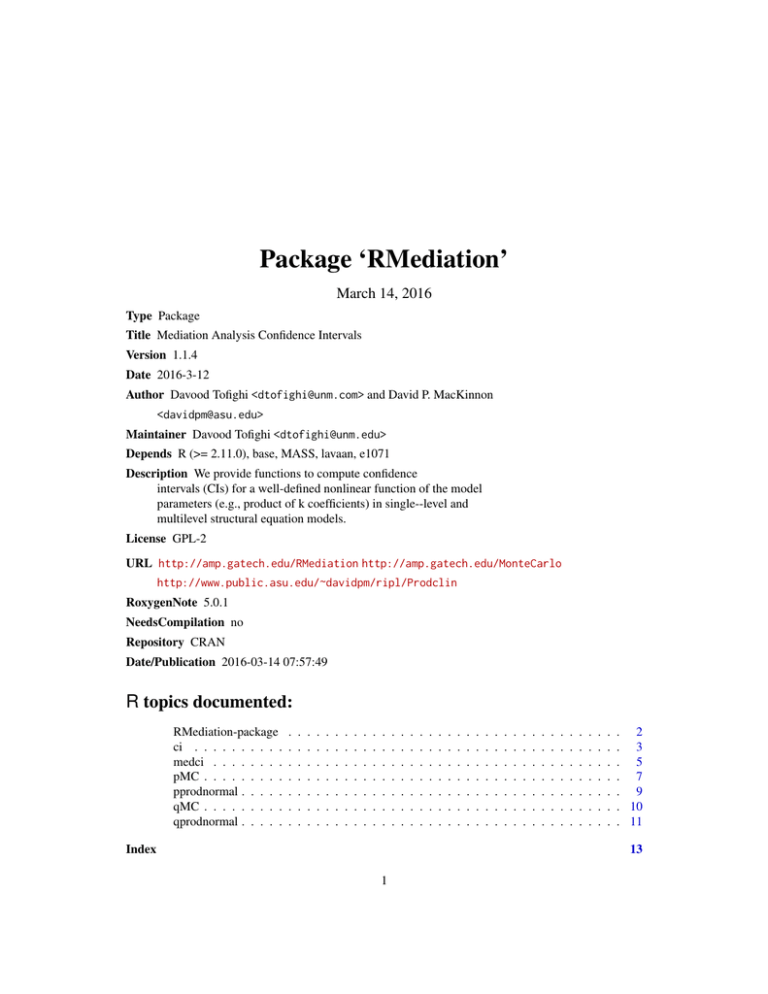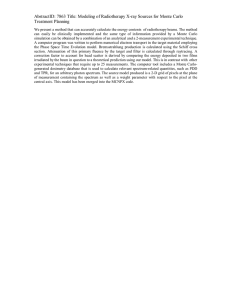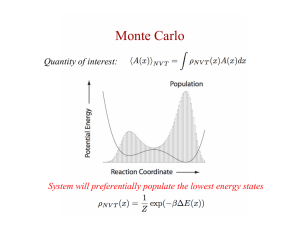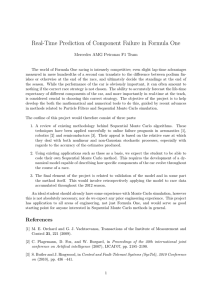Package `RMediation`
advertisement

Package ‘RMediation’ March 14, 2016 Type Package Title Mediation Analysis Confidence Intervals Version 1.1.4 Date 2016-3-12 Author Davood Tofighi <dtofighi@unm.com> and David P. MacKinnon <davidpm@asu.edu> Maintainer Davood Tofighi <dtofighi@unm.edu> Depends R (>= 2.11.0), base, MASS, lavaan, e1071 Description We provide functions to compute confidence intervals (CIs) for a well-defined nonlinear function of the model parameters (e.g., product of k coefficients) in single--level and multilevel structural equation models. License GPL-2 URL http://amp.gatech.edu/RMediation http://amp.gatech.edu/MonteCarlo http://www.public.asu.edu/~davidpm/ripl/Prodclin RoxygenNote 5.0.1 NeedsCompilation no Repository CRAN Date/Publication 2016-03-14 07:57:49 R topics documented: RMediation-package ci . . . . . . . . . . medci . . . . . . . . pMC . . . . . . . . . pprodnormal . . . . . qMC . . . . . . . . . qprodnormal . . . . . . . . . . . . . . . . . . . . . . . . . . . . . . . . . . . . . . . . . . . . . . . . . . . . . . . . . . . . . . . . . . . . . . . . . . . . . . . . . . Index . . . . . . . . . . . . . . . . . . . . . . . . . . . . . . . . . . . . . . . . . . . . . . . . . . . . . . . . . . . . . . . . . . . . . . . . . . . . . . . . . . . . . . . . . . . . . . . . . . . . . . . . . . . . . . . . . . . . . . . . . . . . . . . . . . . . . . . . . . . . . . . . . . . . . . . . . . . . . . . . . . . . . . . . . 2 . 3 . 5 . 7 . 9 . 10 . 11 13 1 2 RMediation-package RMediation-package Mediation Analysis Confidence Intervals Description We provide functions to compute confidence intervals (CIs) for a well–defined nonlinear function of the model parameters (e.g., product of k coefficients) in single–level and multilevel structural equation models. Details Package: Type: Version: Date: License: LazyLoad: RMediation Package 1.1.4 2016-3-12 GPL-2 yes medci produces a CI for the product of two normal random variables using three methods: the distribution of the product of coefficients, Monte Carlo, and asymptotic normal theory with the multivariate-delta standard error (Asymptotic-Delta) method. pprodnormal produces percentiles for the distribution of product of two normal random variables. qprodnormal generates quantiles for the distribution of product of two normal random variables. ci produces a CI for a well–defined nonlinear function of the model parameters in single–level and multilevel structural equation models using the Monte Carlo and Asymptotic-Delta method. Note Two web applications of the RMediation program are available from http://amp.gatech.edu/ RMediation and http://amp.gatech.edu/MonteCarlo. Author(s) Davood Tofighi <dtofighi@unm.edu> and David P. MacKinnon <davidpm@asu.edu> Maintainer: Davood Tofighi <dtofighi@unm.edu> References MacKinnon, D. P., Fritz, M. S., Williams, J., and Lockwood, C. M. (2007). Distribution of the product confidence limits for the indirect effect: Program PRODCLIN. Behavior Research Methods, 39, 384–389. Meeker, W. and Escobar, L. (1994). An algorithm to compute the CDF of the product of two normal random variables. Communications in Statistics: Simulation and Computation, 23, 271–280. Tofighi, D. and MacKinnon, D. P. (2011). RMediation: An R package for mediation analysis confidence intervals. Behavior Research Methods, 43, 692–700. doi:10.3758/s13428-011-0076-x ci 3 Tofighi, D., and MacKinnon, D. P. (2016). Monte Carlo confidence intervals for complex functions of indirect effects. Structural Equation Modeling: A Multidisciplinary Journal, 23, 194-205. http://doi.org/10.1080/10705511.2015.1057284 See Also qprodnormal pprodnormal medci ci Examples medci(mu.x=.2,mu.y=.4,se.x=.1,se.y=.05,rho=0,alpha=.05) pprodnormal(q=.4, mu.x=.5, mu.y=.3, se.x=.03, se.y=.08, rho= 0) qprodnormal(p=.1, mu.x=.5, mu.y=.3, se.x=.03, se.y=.8, rho=0) ci(mu=c(b1=0,b2=0),Sigma=c(1,2,10), quant=~b1*b2) ci(mu=c(b1=1,b2=.7,b3=.6, b4= .45), Sigma=c(.05,0,0,0,.05,0,0, .03, 0, .03), quant=~b1*b2*b3*b4, type="all", plot=TRUE, plotCI=TRUE) ci CI for a nonlinear function of coefficients estimates Description This function returns a (1 − α)% confidence interval (CI) for a well–defined nonlinear function of the coefficients in single–level and multilevel structural equation models. The ci function uses the Monte Carlo (type="MC") and the asymptotic normal theory (type="asymp") with the multivariate delta standard error (Asymptotic–Delta) method (Sobel, 1982) to compute a CI. In addition, for each of the methods, when a user specifies plot=TRUE and plotCI=TRUE, a plot of the sampling distribution of the quantity of interest in the quant argument and an overlaid plot of the CI will be produced. When type="all" and plot=TRUE, two overlaid plots of the sampling distributions corresponding to each method will be produced; when plotCI=TRUE, then the overlaid plots of the CIs for both methods will be displayed as well. Usage ci(mu, Sigma, quant, alpha = 0.05, type = "MC", plot = FALSE, plotCI = FALSE, n.mc = 1e+06, H0 = FALSE, mu0 = NULL, Sigma0 = NULL, ...) Arguments mu (1) a vector of means (e.g., coefficient estimates) for the normal random variables. A user can assign a name to each mean value, e.g., mu=c(b1=.1,b2=3); otherwise, the coefficient names are assigned automatically as follows: b1,b2,.... Or, a lavaan object. Sigma either a covariance matrix or a vector that stacks all the columns of the lower triangle variance–covariance matrix one underneath the other. 4 ci quant quantity of interest, which is a nonlinear/linear function of the model parameters. Argument quant is a formula that must start with the symbol "tilde" (~): e.g., ~b1*b2*b3*b4. The names of coefficients must conform to the names provided in the argument mu or to the default names, i.e., b1,b2,.... alpha significance level for the CI. The default value is .05. type method used to compute a CI. It takes on the values "MC" (default) for Monte Carlo, "asymp" for Asymptotic–Delta, or "all" that produces CIs using both methods. plot when TRUE, plot the approximate sampling distribution of the quantity of interest using the specified method(s) in the argument type. The default value is FALSE. When type="all", superimposed density plots generated by both methods are displayed. plotCI when TRUE, overlays a CI plot with error bars on the density plot of the sampling distribution of quant. When type="all", the superimposed CI plots generated by both methods are added to the density plots. Note that to obtain a CI plot, one must also specify plot="TRUE". The default value is FALSE. n.mc Monte Carlo sample size. The default sample size is 1e+6. H0 False. If TRUE, it will estimate the sampling distribution of H0 : f (b) = 0. See the arguments mu0 and Sigma0. mu0 a vector of means (e.g., coefficient estimates) for the normal random variables that satisft the null hypothesis H0 : f (b) = 0. If it is not provided, smallest z value of mu is zet to zero. Sigma0 either a covariance matrix or a vector that stacks all the columns of the lower triangle variance–covariance matrix one underneath the other. If it is not provided, then Sigma is used instead. ... additional arguments. Value When type is "MC" or "asymp", ci returns a list that contains: (1 − α)% CI a vector of lower and upper confidence limits, Estimate a point estimate of the quantity of interest, SE standard error of the quantity of interest, MC Error When type="MC", error of the Monte Carlo estimate. When type="all", ci returns a list of two objects, each of which a list that contains the results produced by each method as described above. Note The web applications for this function is available at http://amp.gatech.edu/MonteCarlo. Author(s) Davood Tofighi <dtofighi@unm.edu> and David P. MacKinnon <davidpm@asu.edu> medci 5 References Tofighi, D., and MacKinnon, D. P. (2016). Monte Carlo confidence intervals for complex functions of indirect effects. Structural Equation Modeling: A Multidisciplinary Journal, 23, 194-205. http://doi.org/10.1080/10705511.2015.1057284 See Also medci RMediation-package Examples ci(mu=c(b1=1,b2=.7,b3=.6, b4= .45), Sigma=c(.05,0,0,0,.05,0,0,.03,0,.03), quant=~b1*b2*b3*b4, type="all", plot=TRUE, plotCI=TRUE) #An Example of Conservative Null Sampling Distribution ci(c(b1=.3,b2=.4,b3=.3), c(.01,0,0,.01,0,.02), quant=~b1*b2*b3, type="mc", plot=TRUE, plotCI=TRUE, H0=TRUE, mu0=c(b1=.3,b2=.4,b3=0) ) #An Example of Less Conservative Null Sampling Distribution ci(c(b1=.3,b2=.4,b3=.3), c(.01,0,0,.01,0,.02), quant=~b1*b2*b3, type="mc", plot=TRUE, plotCI=TRUE, H0=TRUE, mu0=c(b1=0,b2=.4,b3=0.1) ) medci Confidence Interval for the Mediated Effect Description Produces confidence intervals for the mediated effect and the product of two normal random variables. Usage medci(mu.x, mu.y, se.x, se.y, rho = 0, alpha = 0.05, type = "dop", plot=FALSE, plotCI=FALSE, n.mc = 1e+05, ...) Arguments mu.x mean of x mu.y mean of y se.x standard error (deviation) of x se.y standard error (deviation) of y rho correlation between x and y, where -1 < rho < 1. The default value is 0. alpha significance level for the confidence interval. The default value is .05. 6 medci type method used to compute confidence interval. It takes on the values "dop" (default), "MC", "asymp" or "all". plot when TRUE, plots the distribution of n.mc data points from the distribution of product of two normal random variables using the density estimates provided by the function density. The default value is FALSE. plotCI when TRUE, overlays a confidence interval with error bars on the plot for the mediated effect. Note that to obtain the CI plot, one must also specify plot="TRUE". The default value is FALSE. n.mc when type="MC", n.mc determines the sample size for the Monte Carlo method. The default sample size is 1E5. ... additional arguments to be passed on to the function. Details This function returns a (1 − α)% confidence interval for the mediated effect (product of two normal random variables). To obtain a confidence interval using a specific method, the argument type should be specified. The default is type="dop", which uses the code we wrote in R to implement the distribution of product of the coefficients method described by Meeker and Escobar (1994) to evaluate the CDF of the distribution of product. type="MC" uses the Monte Carlo approach to compute the confidence interval (Tofighi & MacKinnon, 2011). type="asymp" produces the asymptotic normal confidence interval. Note that except for the Monte Carlo method, the standard error for the indirect effect is based on the analytical results by Craig (1936): p (se.y 2 µ.x2 + se.x2 µ.y 2 + 2µ.xµ.yρse.xse.y + se.x2 se.y 2 + se.x2 se.y 2 ρ2 ) In addition, the estimate of indirect effect is µ.xµ.y + σ.xy; type="all" prints confidence intervals using all four options. Value A vector of lower confidence limit and upper confidence limit. When type is "prodclin" (default), "DOP", "MC" or "asymp", medci returns a list that contains: (1 − α)% CI a vector of lower and upper confidence limits, Estimate a point estimate of the quantity of interest, SE standard error of the quantity of interest, MC Error When type="MC", error of the Monte Carlo estimate. Note that when type="all", medci returns a list of four objects, each of which a list that contains the results produced by each method as described above. Note The PRODCLIN programs may be downloaded from http://www.public.asu.edu/~davidpm/ ripl/Prodclin/. A web application of the RMediation program is available from http://amp. gatech.edu/RMediation. pMC 7 Author(s) Davood Tofighi <dtofighi@unm.edu> and David P. MacKinnon <davidpm@asu.edu> References Craig, C. C. (1936). On the frequency function of xy. The Annals of Mathematical Statistics, 7, 1–15. MacKinnon, D. P., Fritz, M. S., Williams, J., and Lockwood, C. M. (2007). Distribution of the product confidence limits for the indirect effect: Program PRODCLIN. Behavior Research Methods, 39, 384–389. Meeker, W. and Escobar, L. (1994). An algorithm to compute the CDF of the product of two normal random variables. Communications in Statistics: Simulation and Computation, 23, 271–280. Tofighi, D. and MacKinnon, D. P. (2011). RMediation: An R package for mediation analysis confidence intervals. Behavior Research Methods, 43, 692–700. doi:10.3758/s13428-011-0076-x See Also qprodnormal pprodnormal ci RMediation-package Examples ##produces CI using PRODCLIN and density plot of distribution of xy (res <- medci(mu.x=.2, mu.y=.4, se.x=1, se.y=1, rho=0, alpha=.05, type="prodclin", plot=TRUE, plotCI=TRUE) ) ## To get a vector of CI estimates res[[1]] ## To get the point estimate of the indirect effect res[["Estimate"]] # Estimate ## To get the SE of the indirect effect res[["SE"]] # SE pMC Probability (percentile) for the Monte Carlo Sampling Distribution of a nonlinear function of coefficients estimates Description This function returns a probability corresponding to the quantile q. Usage pMC(q, mu, Sigma, quant, lower.tail = TRUE, n.mc = 1e+06, ...) 8 pMC Arguments q quantile mu a vector of means (e.g., coefficient estimates) for the normal random variables. A user can assign a name to each mean value, e.g., mu=c(b1=.1,b2=3); otherwise, the coefficient names are assigned automatically as follows: b1,b2,.... Sigma either a covariance matrix or a vector that stacks all the columns of the lower triangle variance–covariance matrix one underneath the other. quant quantity of interest, which is a nonlinear/linear function of the model parameters. Argument quant is a formula that must start with the symbol "tilde" (~): e.g., ~b1*b2*b3*b4. The names of coefficients must conform to the names provided in the argument mu or to the default names, i.e., b1,b2,.... lower.tail logical; if TRUE (default), the probability is P [quant < q]; otherwise, P [quant > q] n.mc Monte Carlo sample size. The default sample size is 1e+6. ... additional arguments. Value scalar probability value. Author(s) Davood Tofighi <dtofighi@unm.edu> and David P. MacKinnon <davidpm@asu.edu> References Tofighi, D. and MacKinnon, D. P. (2011). RMediation: An R package for mediation analysis confidence intervals. Behavior Research Methods, 43, 692–700. doi:10.3758/s13428-011-0076-x See Also medci RMediation-package Examples pMC(.2,mu=c(b1=1,b2=.7,b3=.6, b4= .45), Sigma=c(.05,0,0,0,.05,0,0,.03,0,.03), quant=~b1*b2*b3*b4) pprodnormal pprodnormal 9 Percentile for the Distribution of Product of Two Normal Variables Description Generates percentiles (100 based quantiles) for the distribution of product of two normal random variables and the mediated effect Usage pprodnormal(q, mu.x, mu.y, se.x=1, se.y=1, rho = 0, lower.tail=TRUE, type="dop", n.mc=1e5) Arguments q quantile or value of the product mu.x mean of x mu.y mean of y se.x standard error (deviation) of x se.y standard error (deviation) of y rho correlation between x and y, where -1 < rho < 1. The default value is 0. lower.tail logical; if TRUE (default), the probability is P [X ∗Y < q]; otherwise, P [X ∗Y > q] type method used to compute P [X ∗ Y < q]. It takes on the values "dop" (default), "MC", or "all". n.mc when type="MC", n.mc determines the sample size for the Monte Carlo method. The default sample size is 1E5. Details This function returns the percentile (probability) and the associated error for the distribution of product of mediated effect (two normal random variables). To obtain a percentile using a specific method, the argument type should be specified. The default method is type="dop", which is based on the method described by Meeker and Escobar (1994) to evaluate the CDF of the distribution of product of two normal random variables. type="MC" uses the Monte Carlo approach (Tofighi & MacKinnon, 2011). type="all" prints percentiles using all three options. For the method type="dop", the error is the modulus of absolute error for the numerical integration (for more information see Meeker and Escobar, 1994). For type="MC", the error refers to the Monte Carlo error. Value An object of the type list that contains the following values: p probability (percentile) corresponding to quantile q error estimate of the absolute error 10 qMC Author(s) Davood Tofighi <dtofighi@unm.edu> and David P. MacKinnon <davidpm@asu.edu> References MacKinnon, D. P., Fritz, M. S., Williams, J., and Lockwood, C. M. (2007). Distribution of the product confidence limits for the indirect effect: Program PRODCLIN. Behavior Research Methods, 39, 384–389. Meeker, W. and Escobar, L. (1994). An algorithm to compute the CDF of the product of two normal random variables. Communications in Statistics: Simulation and Computation, 23, 271–280. Tofighi, D. and MacKinnon, D. P. (2011). RMediation: An R package for mediation analysis confidence intervals. Behavior Research Methods, 43, 692–700. doi:10.3758/s13428-011-0076-x See Also medci qprodnormal RMediation-package Examples pprodnormal(q=0, mu.x=.5, mu.y=.3, se.x=1, se.y=1, rho= 0, type="all") qMC Quantile for the Monte Carlo Sampling Distribution of a nonlinear function of coefficients estimates Description This function returns a quantile corresponding to the probability p. Usage qMC(p, mu, Sigma, quant, n.mc = 1e+06, ...) Arguments p mu Sigma quant n.mc ... probability. a vector of means (e.g., coefficient estimates) for the normal random variables. A user can assign a name to each mean value, e.g., mu=c(b1=.1,b2=3); otherwise, the coefficient names are assigned automatically as follows: b1,b2,.... either a covariance matrix or a vector that stacks all the columns of the lower triangle variance–covariance matrix one underneath the other. quantity of interest, which is a nonlinear/linear function of the model parameters. Argument quant is a formula that must start with the symbol "tilde" (~): e.g., ~b1*b2*b3*b4. The names of coefficients must conform to the names provided in the argument mu or to the default names, i.e., b1,b2,.... Monte Carlo sample size. The default sample size is 1e+6. additional arguments. qprodnormal 11 Value scalar quantile value. Author(s) Davood Tofighi <dtofighi@psych.gatech.edu> and David P. MacKinnon <davidpm@asu.edu> References Tofighi, D. and MacKinnon, D. P. (2011). RMediation: An R package for mediation analysis confidence intervals. Behavior Research Methods, 43, 692–700. doi:10.3758/s13428-011-0076-x See Also medci RMediation-package Examples qMC(.05,mu=c(b1=1,b2=.7,b3=.6, b4= .45), Sigma=c(.05,0,0,0,.05,0,0,.03,0,.03), quant=~b1*b2*b3*b4) qprodnormal Quantile for the Distribution of Product of Two Normal Variables Description Generates quantiles for the distribution of product of two normal random variables Usage qprodnormal(p, mu.x, mu.y, se.x, se.y, rho=0, lower.tail=TRUE, type="dop", n.mc=1e5) Arguments p mu.x mu.y se.x se.y rho lower.tail type n.mc probability mean of x mean of y standard error (deviation) of x standard error (deviation) of y correlation between x and y, where -1 < rho < 1. The default value is 0. logical; if TRUE (default), the probability is P [X ∗Y < q]; otherwise, P [X ∗Y > q] method used to compute P [X ∗ Y < q]. It takes on the values "dop" (default), "MC", or "all". when type="MC", n.mc determines the sample size of Monte Carlo method. The default sample size is 1E5. 12 qprodnormal Details This function returns a quantile and the associated error (accuracy) corresponding the requested percentile (probability) p of the distribution of product of mediated effect (product of two normal random variables). To obtain a quantile using a specific method, the argument type should be specified. The default method is type="dop", which uses the method described by Meeker and Escobar (1994) to evaluate the CDF of the distribution of product of two normal variables. type="MC" uses the Monte Carlo approach (Tofighi & MacKinnon, 2011). type="all" prints quantiles using all three options. For the method type="dop", the error is the modulus of absolute error for the numerical integration (for more information see Meeker and Escobar, 1994). For type="MC", the error refers to the Monte Carlo error. Value An object of the type list that contains the following values: q quantile corresponding to probability p error estimate of the absolute error Author(s) Davood Tofighi <dtofighi@unm.edu> and David P. MacKinnon <davidpm@asu.edu> References MacKinnon, D. P., Fritz, M. S., Williams, J., and Lockwood, C. M. (2007). Distribution of the product confidence limits for the indirect effect: Program PRODCLIN. Behavior Research Methods, 39, 384–389. Meeker, W. and Escobar, L. (1994). An algorithm to compute the CDF of the product of two normal random variables. Communications in Statistics: Simulation and Computation, 23, 271–280. Tofighi, D. and MacKinnon, D. P. (2011). RMediation: An R package for mediation analysis confidence intervals. Behavior Research Methods, 43, 692–700. doi:10.3758/s13428-011-0076-x See Also medci pprodnormal RMediation-package Examples ##lower tail qprodnormal(p=.1, mu.x=.5, mu.y=.3, se.x=1, se.y=1, rho=0, lower.tail = TRUE, type="all") ##upper tail qprodnormal(p=.1, mu.x=.5, mu.y=.3, se.x=1, se.y=1, rho=0, lower.tail = FALSE, type="all") Index ∗Topic distribution ci, 3 medci, 5 pMC, 7 pprodnormal, 9 qMC, 10 qprodnormal, 11 RMediation-package, 2 ∗Topic regression ci, 3 medci, 5 pMC, 7 pprodnormal, 9 qMC, 10 qprodnormal, 11 RMediation-package, 2 ci, 2, 3, 3, 7 density, 6 formula, 4, 8, 10 lavaan, 3 list, 4, 6, 9, 12 medci, 2, 3, 5, 5, 8, 10–12 pMC, 7 pprodnormal, 2, 3, 7, 9, 12 qMC, 10 qprodnormal, 2, 3, 7, 10, 11 RMediation-package, 2 vector, 3, 4, 8, 10 13




